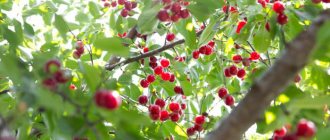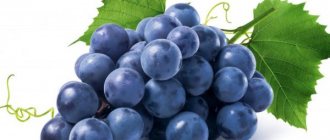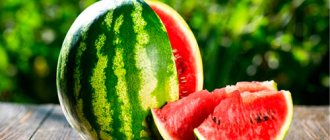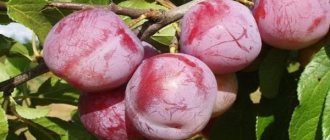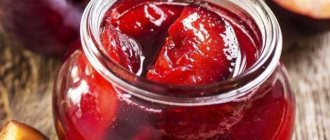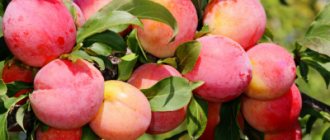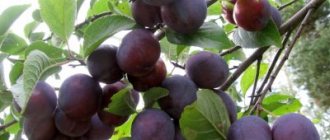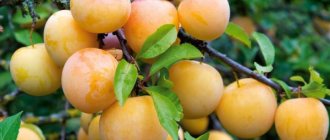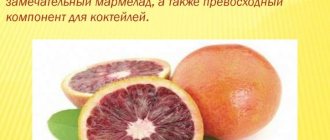Useful qualities of plum
People use the fruits of wild and cultivated plants for food, for processing into juices, preserves, jams, liqueurs, as a filling for baked goods, and as medicinal raw materials. The domestic plum has long been grown for its juicy drupes with a bluish coating. Home plum fruits contain:
- carbohydrates (fructose, glucose);
- vitamins C, A, P, group B;
- organic acids;
- tannins;
- microelements;
- pectins.
Preparations from the pulp of plum fruits and seeds are used in folk and official medicine. Prunes are used in dietary nutrition and confectionery production. Plum blossoms early and profusely, even before the leaves fully bloom. Trees and shrubs look very elegant and are valued in landscape design. Traditionally, in the 20th century, two groups of varieties were distinguished within the species - Hungarians and Renclods. The first are represented by trees and shrubs with blue-violet round or elongated fruits. Renclods often have spherical fruits of a greenish color. Now the main direction is the breeding of undersized subspecies, interspecific crossing and obtaining hybrids, for example, plum and apricot.
What is a plum - a berry or a fruit?
Are grapes a berry or a fruit?
Plum has the characteristics of berries, and at the same time we all know it as an extremely tasty and healthy fruit. And yet, is a plum a fruit or a berry? It is impossible to give a definite answer, so scientists today argue about the plum, putting forward diametrically opposed theories.
Plum is a fruit plant belonging to the Rosaceae family. This tree is found everywhere today. It is known that plum is a natural hybrid of sloe and cherry plum. And the plant itself has characteristics of both a classic fruit and berries. This led to certain difficulties in classification. Many summer residents and gardeners do not know for sure whether a plum is a berry or a fruit. This is exactly what we will talk about in this article.
The problem with the definition is that today there are low-growing varieties of this tree, which can be up to one and a half meters high. It is not surprising that many summer residents consider such plums to be shrubs, and as you know, the fruits of a bush are a berry. This is where confusion in concepts arises. And yet, for a correct determination, it is necessary to consider wild pure varieties, which will allow us to draw the correct conclusion.
First of all, let’s look at what is considered to be a fruit. It is an edible juicy fruit of a bush or tree. Based on the definition, we can conclude that even bushy plums are classified as fruits.
A fruit is formed in place of a fertilized flower, which, after pollination, accumulates nutrients and becomes juicy and edible. Inside it contains one or several seeds, which under natural conditions, after ripening, fall to the ground and, germinating, give life to a new plant.
Plum fruits contain one seed, while berries belong to the category of multi-seeded fruits. Based on this feature alone, it is by definition impossible to classify plums as berries. According to biological scientific definitions, there are certain differences between berries and fruits. However, in everyday life they usually do not make distinctions. Therefore, it would not be a mistake if this plant is related to berries. Yet even berries are, in fact, the fruits of a tree or shrub. The only difference is in the number of seeds.
Planting a crop
In the ranking of fruit trees, plum ranks third in popularity after apple and cherry. In order for it to grow, it is important to choose the right area for planting. The culture does not like dark places, so the area should be sunny, protected from the wind and the shade of other garden trees. Plum develops well if the soil:
- moderately humid;
- loamy;
- drained;
- neutral reaction;
- rich in nutrients.
Depending on climatic conditions, it can be planted in spring or autumn. Process technology:
- 14 days before planting, dig a hole so that the soil can settle.
- The excavated soil is mixed with humus in a ratio of two to one.
- A seedling is placed in the center of the hole and nearby, on the north side, a peg is driven in to support the tree.
- The root collar should protrude 5-8 cm above the ground surface.
- Carefully, so that there are no voids, the previously dug soil is poured into the planting hole.
- The seedling is watered abundantly and the surface of the soil is mulched with compost or peat.
In the fall, there is a possibility that the plum will not have time to take root and will freeze in the winter. Spring planting is carried out after the ground has warmed up.
Plum varieties
Southern tree
Plum varieties
Plum, whose benefits for the human body are invaluable, has many varieties that differ in ripening time, taste characteristics, shape, and color.
In our latitudes, the most popular varieties are those described below:
- Home plum. The tree has an ovoid-shaped crown and begins to bear fruit in the second year after planting. The fruits can be yellow, red, purple, blue-black. The shape of the fruit can be elongated or round. Due to its high taste characteristics, this variety began to quickly spread throughout our country. The fruits are large, aromatic, sweet. Dried plums of this variety are called prunes, which are a valuable dried fruit actively used in cooking.
- Chinese plum. It is grown in almost all climatic zones of the country. The tree, as a rule, does not grow higher than 2 meters. The crown is spherical, spreading, oval-shaped leaves. The fruits of the plant are juicy and aromatic. Chinese plum is suitable for fresh consumption, as well as for canning and preparing for the winter. Varieties of yellow-fruited Chinese plums have high dessert qualities.
- Peach plum. A tree of medium height with a rounded, medium-leafed crown. The fruits are large, weigh on average 65 - 70 g, round or ovoid in shape with a small groove in the middle. The fruits are juicy, aromatic, sweet with a hint of barely noticeable sourness. This type of plum ripens early - at the end of July, beginning of August. Peach plum is resistant to pests and diseases and, with proper care, produces high yields.
- Plum Egg. The fruits are egg-shaped and yellow or purple in color. The fruits are soft, juicy, excellent for fresh consumption, as well as for processing.
- Plum Hungarian. The fruits are red or dark purple with a bloom. The shape can be round, oval, ovoid. The pulp is dense and sweet. This plum is prepared for the winter for pies, and also as dried fruit.
- Plum Renklod. Fruits with dense pulp, juicy, sweet. The fruit is best consumed fresh immediately, because it is not stored for long and does not tolerate transportation.
- Canadian plum. Winter-hardy, late-ripening variety. The pulp is dense, juicy, aromatic.
Damage to plums
Plum
The body reacts poorly to large amounts of fruit eaten. Everything needs moderation. And any benefit will be reduced to zero if plum consumption is huge. 6 large fruits are enough to replenish your reserves of useful components and feel good.
For a certain category of people, plums are harmful:
- with obesity or diabetes due to the presence of easily digestible sugars in the composition;
- in case of gastritis with high acidity;
- for muscle and joint inflammation;
- mothers during lactation, as the baby suffers from colic and diarrhea;
- with individual intolerance (allergy to plum);
- in the presence of stones in the gall bladder.
Plum, like any fruit, has its positive and negative sides. But moderate consumption will delight you with its excellent taste and improve your mood. A delicious dessert brings the aromas of summer when the landscape outside is rainy and the time of autumn blues sets in.
Home plum is found in most gardens in our country and the world. Tasty, nutritious and healthy fruits are why this species is so widely popular.
Contraindications for use
Plum, despite all its beneficial properties, can also cause harm. It is not recommended to use it in the following cases:
- It is contraindicated for diabetes mellitus, as it contains a lot of sugar;
- You should not give plum to small children - it causes bloating and can cause diarrhea;
- Gastritis of the stomach with high acidity;
- For obesity;
- The use of plums for gout is contraindicated.
It is imperative to remember that unripe fruits of the plum tree are useless, and moreover, they can be harmful to health. Also, it is better to eat plums fresh, because heat treatment wastes 30% of the vitamins.
Plum is a berry or fruit
People call products differently than they are called from a scientific point of view. Often adults and children ask, is a plum a berry or a fruit? Although the answer is obvious, this issue should be examined in more detail.
What is plum
Many people prefer to call the fruits of vegetation berries. But what is this product actually, a berry or a fruit? It is impossible to classify a plum as a berry, since it has only one bone, while the harvest of berry plants contains several small seeds, therefore, a plum is a fruit. It is also difficult to classify the plant as a vegetable.
It should also be noted that the fruits ripen on bushes and trees, which means they should be classified as fruits, despite their small size. But despite the botany, people are more accustomed to calling plums berries.
Bush or tree
Depending on the type of plant, it can be either a tree or a shrub. On average, the height of vegetation ranges from 2 to 10 meters. There are also lower shrubs, but as a rule, they belong to hybrids, often plum-cherry.
What kind
Fruits can be multi-seeded (contain many seeds) or single-seeded (one seed in the center); plums are classified as single-seeded. Wikipedia says that the fruit can be yellow, purple, red or lilac in color.
Benefit
Plum is a product with low energy value. 100 grams contain only 48 kilocalories.
The fruits of the plum tree contain:
- carbohydrates;
- iron;
- vitamin A;
- ascorbic acid;
- B vitamin compounds;
- magnesium;
- potassium;
- pectin;
- tannins;
- various microelements.
Plum fruits are used for culinary and medicinal purposes. In cooking, the product is used to prepare fruit drinks, juices and various desserts.
If you don’t understand medical terms, the beneficial properties of the plant can be described as follows:
The pulp and juices of the fruit help normalize stool during constipation and improve intestinal motility. The dried product helps reduce the amount of cholesterol in the blood. Fresh fruits improve the functioning of the urinary system and help remove salts from the body. An infusion made from plum leaves thins the blood and prevents blood clots. Plum decoction has a healing effect and helps slow down the aging process in cells. Daily consumption of the product helps improve the body's defenses, which is important, especially when it comes to cold season. The acids contained in the fruits help improve the condition of gastritis with low acidity levels. Plum pulp improves protein metabolism in the human body. Fruits help normalize blood pressure in case of hypertension and one-time disorders. The fruits of the plant are able to increase the level of hemoglobin in the blood, preventing the development of iron deficiency anemia.
The beneficial properties of the product are recognized not only in medicine, but also in cosmetology. Plum pulp is used to improve the condition of the skin and hair. By using plant-based products twice a week, you can thoroughly nourish your skin with all the necessary nutrients and microelements.
Note! The presented beneficial properties are inherent in dried or fresh fruits. Heat-treated fruits lose a third of their nutrients
It should also be remembered that plums are a perishable product, so they must be consumed within a short time.
Contraindications
A person who eats fruit can not only benefit his body, but also harm it.
It is not recommended to consume plum tree fruits:
- during diarrhea;
- with an increased amount of sugar in the blood;
- children under 3 years of age (may cause increased gas formation and diarrhea);
- in the presence of peptic ulcer and gastritis with increased acidity;
- with excess body weight;
- for gout.
Many people are interested in the question: is it possible to eat unripe fruits? Unripe fruits contain substances that have a negative effect on the human body. Even if the negative impact is not pronounced, there will be no benefit either.
The nutrients obtained from plums are quickly and almost completely absorbed by the body, which helps replenish the supply of nutrients in a short time.
The harvest from a fruit tree has high nutritional value for the human body, regardless of what term they are called by. Regular consumption of fruits can replace the intake of synthetic vitamin compounds and even some pharmacological agents.
Chemical composition
The fruit is rich in various vitamins, as well as micro- and macroelements, valuable for the human body. The calorie content of fresh plums is only 45 calories per 100 g:
- proteins – 0.8 g;
- fats – 0.3 g;
- carbohydrates – 9.6 g;
- water – 86.3 g;
- dietary fiber – 1.5 g.
However, it is necessary to take into account that prunes are higher in calories than fresh fruit. Its nutritional value is about 255 kcal.
The fruits contain 9-15% sugars, namely fructose, sucrose and glucose. The fruits are also rich in minerals (listed in Table 1) and vitamins of groups A, B1, B2, C, H and PP.
| Microelements | Macronutrients |
| Fe | Ca |
| Manganese | Potassium |
| Fluorine | Chlorine |
| Nickel | Magnesium |
| Zn | Phosphorus |
| Iodine | Sulfur |
| Silicon | Sodium |
| Copper | |
| Chromium |
Due to its rich composition, plum is a useful fruit for vitamin deficiency.
Benefits of plums for children
Pediatricians recommend plums as complementary foods from 8 months. The first portions should be small: one or two tablespoons of plum puree or juice. In the future, the amount can be increased, but only slightly. Plum is very weak and causes intestinal upset and diarrhea.
In childhood, when the gastrointestinal tract organs are not fully formed, babies experience constipation. In this case, the benefits of plums are simply invaluable. If you don’t have fresh fruits, you can make compote from dried fruits or buy ready-made puree for children. The puree is added in small quantities to porridge or curds.
It is necessary to ensure that the child does not eat a lot of fruits at one time, which leads to the same sad consequences: digestive disorders, abdominal pain, heartburn, diarrhea.
Plum varieties
Plum varieties are divided into three categories:
- early: July, Zarechnaya early, Skoroplodnaya;
- mid-season: Souvenir of the East, Romain;
- late: President, Empress.
There are also varieties of yellow plums, the most popular of which are:
- Egg;
- Altai Anniversary;
- Honey white.
Early ripening varieties
Such plums are especially valued for growing for sale, as they bring maximum profit.
July
The main characteristics are as follows:
- the first fruits will ripen at the end of July;
- a tree of medium size and density with arched shoots;
- the fruits are red and ovoid, weighing about 30 g;
- the pulp is yellow, sweet in taste;
- the harvest from one tree reaches 12 kg;
- begins to bear fruit in the 3rd year.
The July plum variety loves sun and moderate soil moisture. It is consumed both fresh and canned.
Zarechnaya early
Early Zarechnaya plum has the following characteristics:
- ripens in mid-July;
- a medium-height tree with straighter branches;
- the fruits are large, blue, and have a waxy coating;
- the pulp is yellow, sour in taste;
- regular yield, up to 15 kg of plums per tree;
- bears fruit in 3-4 years.
This plum is suitable for table use and has good taste.
Precocious
Winter-hardy plum has the following characteristic qualities:
- ripening occurs in July-August;
- the crown of the tree is fan-shaped;
- the fruits are small, up to 25 g, red;
- the pulp is juicy and aromatic;
- begins to bear fruit in the 4th year;
- the average yield is 10 kg per tree.
The life span of a precocious plum is up to 20 years. It is well transported and belongs to the dessert varieties.
Mid-season varieties
The varieties that ripen in mid-summer are especially valued by gardeners, as they have the brightest and most intense aroma. It is from these fruits that the most delicious tinctures and jams are obtained.
Souvenir of the East
Quite a popular plum variety, bred by selectors. Main characteristics:
- does not grow tall, up to 2.5 m;
- plum fruits are large, beautiful, dark blue in color, weighing up to 40 g;
- the pulp is yellow, dense, crispy, sweet in taste;
- The yield reaches 40 kg per tree.
An excellent table plum variety with a high level of fruiting. It is used in the same way as technical.
Romain
Romaine plum has the following qualities:
- ripens in mid-August;
- the leaves have a reddish tint;
- the fruit is red, like the flesh;
- average fruit size (20-25 g), high quality.
This plum is perfect for growing in a summer cottage. It bears fruit regularly and is used both for food and for winter storage.
Late plum varieties
They are used for harvesting and storing plums for the winter, and are often used for preservation. Most of the late varieties are frost-resistant and grow well in the northern zone of Russia.
The president
Plum President is universal in use. Character traits:
- ripening occurs in mid-September;
- large fruits, weighing up to 50 g, have a blue color with a waxy coating;
- the pulp is yellow, juicy;
- A middle-aged tree brings up to 40 kg of harvest, an adult tree – up to 70 kg.
President plum fruits are easily transported and stored for up to 2 weeks. They are used to prepare prunes. The tree is winter-hardy.
Empress
The table plum variety has the following qualities:
- tall tree, up to 4 m in height;
- the harvest from one tree is up to 20 kg;
- bears fruit in 4-5 years;
- Fruit ripening occurs in the second half of September;
- plum color is dark purple, average weight 45-50 g;
- The pulp is yellow, juicy.
This plum is used for making juices and canning. Transports well.
Short description
Home plum is one of the most common species from the Rosaceae family in Russia and the world. The species was obtained by natural pollination of blackthorn and cherry plum. It has not yet been possible to reconstruct the exact picture of the origin of the species, but it is believed that its homeland may be the territory from the Eastern Caucasus to the eastern coast of the Adriatic. This includes Asia Minor and the Balkan Peninsula. This knowledge will allow scientists to eventually obtain a picture of the origin and distribution of the domestic plum.
On the territory of Russia, the first plums appeared in the middle of the 17th century in the garden of the royal family near Moscow, located in the village of Izmailovo. They were brought there from Western Europe. Today they are widespread throughout the world, Europe, Russia, China, and the USA.
What does a plum look like?
Home plum is a woody plant up to 15 meters in height with an ovoid crown. The foliage is simple, alternately arranged, with a short petiole. Its length is usually 4-10 cm, width varies from 2 to 5 cm. Flower buds are also simple and form 1-3 flowers. Self-fertility varies depending on the characteristics of the particular variety, but the presence of other varieties in the garden will always increase plum yield. The plum fruit is a single drupe with a color ranging from light yellow to deep purple, most often blue. The bone is flattened and pointed at both ends.
Important: a ripe crop must be protected not only from pests, but also from birds
How long does a plum live?
The lifespan of one tree is usually approximately a quarter of a century. It takes 10-15 years for the plant to fully bear fruit.
House plum is one of the divisions of the genus Plum, which includes more than 250 species. Among them, the most related to the domestic plum are:
- American plum;
- cherry plum (Russian plum);
- dwarf plum;
- Moldovan plum;
- Chinese plum, etc.
Home plum differs from the indicated species in color, taste and some other external characteristics. May vary:
- productivity;
- adaptability;
- winter hardiness;
- resistance to pests and diseases, etc.
Please note: the difference between plum species plays an important role in breeding
Plum is a berry or fruit
It is generally accepted to include plum fruits in the category of fruits, but recently there has been an opinion that they are berries. In botany, it is generally accepted that berries are fruits with many seeds that ripen on bushes or herbaceous plants. From this point of view, plum fruits that grow on tree plantations and have one seed cannot be classified as berries. However, thanks to breeding achievements, it was possible to obtain varieties or discover species that form small fruits on bush-like plants. In this regard, the question arose about classifying plums as berries.
Based on botanical definitions, it would be more correct to classify plums as fruits. The fruit is a juicy fruit formed on woody or shrubby plants, resulting from the pollination of a flower, having one or more seeds that sprout when they fall into the ground. This definition is closer to plum than the definition of berry. Thus, plum is a fruit.
Plum: tree or shrub
For more accurate selection and cultivation, it is necessary to know the answer to the question: is a plum a tree or a shrub? There are various varieties of plums in cultivation, but the domestic plum in question is a tree.
Additional information: the plant retains this form even when crossed with tree species.
Reproduction methods
There are 4 effective ways to propagate plums. The gardener will only have to choose the one he likes. By using one of them, you won’t have to buy seedlings. Reproduction methods:
- By cuttings. For this method, it is necessary to prepare green cuttings in July, when the shoots at the base turn red. In rainy or cloudy weather, a healthy shoot 25-30 cm long is cut from which cuttings with 3-4 leaves are cut. When cut, one end is made straight, the other at an angle of 45º. For 14 hours, the shoot is dipped into a growth-stimulating solution, after which it is planted in a bed under a film. In spring, seedlings are planted in a permanent planting site.
- Root shoots. Only root-capable plums are propagated using this method. Two-year-old shoots are dug up from a tree with a well-developed root system. This is done in the spring before the buds open. The plum shoots are shortened by 1/3 and planted in a permanent place.
- Taps. This method is used in the spring, when the soil warms up. The side shoot of the plum is bent into the dug trench, leaving the crown 15-20 cm long outside and the trench is covered with soil. The ground around the outlet is covered with covering material. In autumn, the shoot is separated from the mother shoot and planted.
- Bones. This method is for obtaining plum rootstock. Later, buds or cuttings of varietal specimens are grafted onto it.
Each of these methods has its pros and cons and requires patience and certain knowledge. Regardless of the method used to obtain the seedling, it is necessary to water it on time, loosen the soil and feed it with organic fertilizers.
Health Benefits of Plum
Health Benefits of Plum
Ripe plum fruits are consumed fresh or cooked. The fruit improves appetite, normalizing the activity and secretory function of the gastrointestinal tract. Plum is also known for its mild laxative and diuretic effect.
These fruits must be included in the diet of people diagnosed with the following diseases:
- anemia;
- pathologies of the heart and blood vessels;
- renal dysfunction;
- rheumatism;
- gout;
- atherosclerosis;
- intestinal atony.
Men
The stronger half are especially susceptible to cardiovascular pathologies, but the presence of plums in the diet will help prevent such dangerous diseases as:
- myocardial infarction;
- stroke;
- atherosclerosis.
The fruit reduces the load on the liver, so homemade plum compote is an excellent remedy for relieving withdrawal symptoms after alcohol abuse.
Potassium present in the fruits of the plant promotes active contraction of muscle tissue after strength training. Fresh fruits eaten for dinner calm the nervous system, help you relax and fall asleep faster.
Women
For the fair half, plums are a salvation during menopause. Regular consumption of fresh fruits helps normalize hormonal levels and prevent breast cancer. The fruit is useful to consume in the second phase of the menstrual cycle, especially if a woman complains of disorders such as:
- severe premenstrual syndrome;
- severe swelling;
- painful, heavy bleeding.
During pregnancy, the product will saturate the expectant mother’s body with vital vitamins, and will also help normalize the functioning of the digestive system, eliminating such an unpleasant problem as chronic constipation. However, do not forget that plums stimulate appetite, so in order not to gain excess before giving birth, you need to consume fruits in moderation - 5-6 pieces a day.
Children
For a growing organism, plums also undoubtedly bring great benefits. You can introduce your child to fruit for the first time at 5–6 months, when the first complementary foods are introduced. Prunes can be added to milk porridges, and compotes can be made from fresh fruits. From the age of eight months, it is recommended to give your baby yellow or red plum puree.
Pediatricians advise older children to include plums in their diet to:
- improve the functioning of the digestive system;
- strengthen the immune system;
- protect eyesight;
- calm the nervous system.
Watch this video on YouTube
Plum varieties
There are many varieties of plums. The most common types are the following:
- Homemade plum. The height of the tree can reach 15 meters. The fruits come in different colors - yellow, blue, red and purple. All of them are used as food. The plant can be 25 years old and bears fruit for 10-15 years.
- The prickly plum (spike) is a small bush with thorns. Can grow up to 4-5 meters. The fruit is small, blue, covered with a plate, and has one bone. Such fruits have a sour, tart taste and are widely used in folk medicine.
- Chinese plum is a tree 10-12 meters high. The fruits are yellow, pear-shaped or oval, up to 5 cm in diameter, and have a purple-red color. This type of plum is grown quite rarely.
- Portuguese cherry laurel is an evergreen shrub that can grow up to 1 meter. The shape of the plum is similar to an egg. The fruits have a bitter-sour taste and have one bone.
- Sea plum is another plant species that grows only on the Atlantic coast of the North American continent. The height of the bushes is small, only 2-4 meters. The fruits are small, up to 2 cm in diameter, and they also have one bone.
The difference between plum and cherry plum
The difference between cherry plum and plum, first of all, in these varieties of fruits, differs in color. Cherry plums are usually yellow and red and blue plums.
These two products differ in chemical composition and nutritional value. For example, plums contain more sugars and less calcium than cherry plums.
Cherry plums grow in the southern regions, especially in the Caucasus. This is due to the fact that the plant is not able to withstand low temperatures. Plums are found in all areas with temperate climates.
The fruits of the cherry plum ripen by the end of summer - beginning of autumn, the plum bears fruit much earlier. Cherry fruits begin to bear fruit two years earlier than plums.
Plums are much easier to dry. In addition, this species is less susceptible to pests. In our natural conditions, it does not require special means for its cultivation. Thanks to this, the product is environmentally friendly. The plumage is also vulnerable to disease and not resistant to pests.
Plum tree care
Comfortable conditions created for the seedling guarantee that it will take root in a new place. To do this, it needs to be watered, fed, pruned, loosened and mulched, and covered for the winter.
In dry weather, the tree must be watered at least once a week. The soil should be moist at a depth of 45 cm. Water consumption:
- 40 l for a young tree;
- 60 l for an adult.
To prevent the plum from freezing in winter, the thickness of the snow near the tree is maintained at no more than 60 cm.
The first feeding is done at the age of two years. An organic solution or a complex mixture with a high nitrogen content is applied under the tree. In autumn, plums are fed with potassium and phosphorus fertilizers.
Since the fruit likes to weave its branches chaotically, it is necessary to regularly arrange the crown. This should be done as a seedling. The trunk 40 cm from the ground is cleared of side branches, and the rest is cut in half. The central conductor should be up to 1.5 m. Over the next 5 years, the crown continues to form using this process.
In order for air to flow to the roots after rain or watering, the soil under the tree must be loosened. And to prevent the roots from freezing, the soil drying out and the growth of weeds, the plum tree trunk circle is covered with mulch. For the first two years of winter, the trunk of the seedling is wrapped with covering material.
